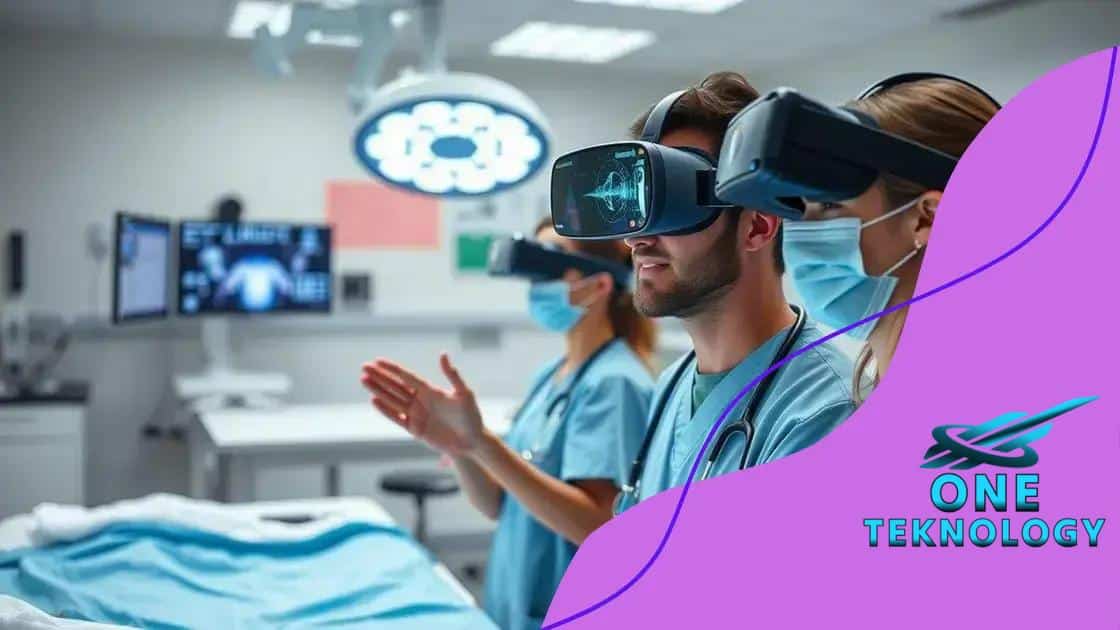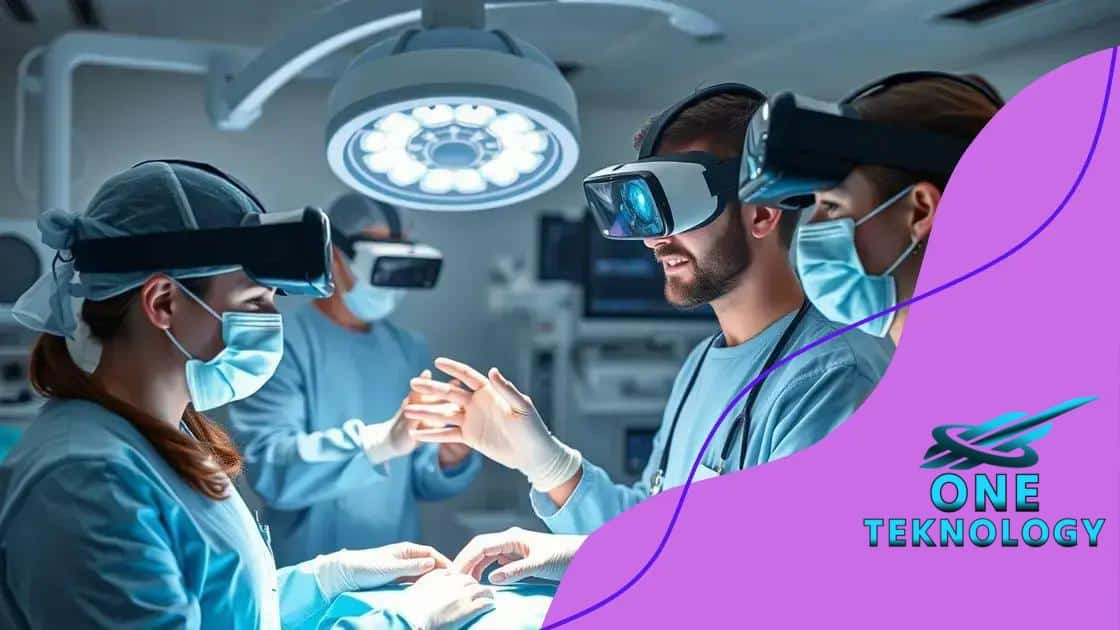The impact of AR and VR in medical education

The impact of AR and VR in medical education enhances training by providing immersive, realistic experiences that improve skill acquisition, knowledge retention, and access to diverse learning scenarios for future healthcare professionals.
The impact of AR and VR in medical education is paving the way for revolutionary learning experiences. Have you ever imagined training future doctors in lifelike simulations? This potential is currently being realized, reshaping educational pathways.
Understanding AR and VR technologies
Understanding AR and VR technologies is essential for grasping their impact on medical education. Augmented Reality (AR) overlays digital information onto the real world, enhancing the way students interact with their environment. Virtual Reality (VR), on the other hand, immerses learners in a fully digital environment, allowing for hands-on experiences without any risk.
What is Augmented Reality?
Augmented Reality enhances the real world by adding digital elements to it. This can be through smartphones or special AR glasses. For example, medical students can see anatomical structures in 3D while examining a cadaver.
- Interactive learning experiences.
- Visual reinforcement of complex concepts.
- Safe environment for practicing procedures.
What is Virtual Reality?
Virtual Reality acts as a tool to bring learners into a simulated environment. In medical training, this allows students to perform surgeries or diagnose patients in a risk-free setting. The lifelike scenarios help build their confidence.
- Full immersion for effective learning.
- Realistic simulation of medical scenarios.
- Ability to practice without consequences.
Both AR and VR are revolutionizing education. They provide students a platform to explore and practice in ways that traditional methods cannot offer. By utilizing these technologies, future healthcare professionals can learn faster and retain more information.
The benefits of immersive learning
The benefits of immersive learning in medical education are significant and far-reaching. This approach engages students deeply, making complex subjects more understandable. By utilizing technologies like AR and VR, learners can interact with realistic scenarios that enhance their understanding and retention of knowledge.
Enhanced Engagement
Immersive learning captures students’ attention more effectively than traditional methods. They become active participants in their education, increasing motivation and interest in the material.
- Realistic simulations that mimic real-life scenarios.
- Interactive environments that encourage exploration.
- Immediate feedback to promote learning from mistakes.
Improved Knowledge Retention
Research indicates that students who are actively involved in their learning retain information better. Immersive experiences allow medical students to practice without the fear of making critical errors.
- Hands-on practice reinforces memory.
- Realistic contexts help students connect theory to practice.
- The ability to revisit scenarios enhances learning.
Moreover, immersive learning addresses various learning styles. Some students might excel with hands-on experiences, while others benefit from visual and auditory elements offered by AR and VR. This inclusiveness fosters a richer educational atmosphere where each learner can thrive. As these technologies evolve, so do the opportunities for students to develop their skills more effectively, preparing them for real-world challenges.
Real-world applications in medical training

Real-world applications in medical training through AR and VR are transforming how future healthcare professionals acquire skills. These technologies offer practical experience without the real-life risks that come with traditional training methods.
Simulated Surgical Procedures
One of the most significant benefits is the ability to practice surgical techniques in a completely safe environment. Students can perform virtual surgeries, allowing them to understand the intricacies of procedures without endangering patients.
- Enhanced dexterity through repeated practice.
- Immediate feedback on performance.
- Exposure to a variety of cases and complications.
Diagnosis and Patient Interaction
VR also creates realistic scenarios for diagnosing patients. Medical students can interact with virtual patients, consulting on symptoms and treatment options. This builds their communication skills in a safe environment.
- Improved bedside manner.
- Hands-on learning in patient assessment.
- Practicing empathy and understanding.
Furthermore, these technologies can simulate emergency situations, enabling students to respond under pressure. Training with AR and VR allows for real-time decision-making and critical thinking development. As medical training evolves, incorporating these immersive technologies ensures that future doctors are better prepared for their roles.
Challenges faced in integrating AR and VR
Integrating AR and VR into medical education presents several challenges. While these technologies offer groundbreaking opportunities, there are barriers that educators and institutions must overcome to implement them effectively.
Cost of Technology
The initial investment for AR and VR technology can be high. Equipment, software, and maintenance costs can strain budgets, especially for smaller institutions. However, many organizations are exploring partnerships and grants to help finance these advancements.
- High costs of VR headsets and AR devices.
- Expenses related to software development.
- Ongoing maintenance and updates required.
Training and Support
Effective integration requires that educators are not only familiar with the technology but also skilled in using it. Many instructors may need additional training, which can take time and resources. Proper support is crucial to help both teachers and students adapt to new methods.
- Need for professional development for faculty.
- Creating user-friendly platforms for students.
- Availability of technical support during training.
Moreover, there can be resistance to change from traditional teaching methods. Some educators may be reluctant to adopt new technologies, fearing they may disrupt established educational practices. Addressing these concerns is critical for successful implementation. While the integration of AR and VR is challenging, addressing these issues can pave the way for more effective medical training in the future.
Future prospects for AR and VR in healthcare education
The future prospects for AR and VR in healthcare education are promising and full of potential. As technology advances, these immersive tools are becoming essential in training medical professionals efficiently. With the ability to simulate real-life scenarios, students can practice skills that are critical in high-pressure situations.
Expanding Access to Education
One significant advantage is the potential for remote learning. Students from different locations can access high-quality training without needing to be physically present in a classroom. This accessibility can greatly enhance learning opportunities.
- Online VR training sessions for remote students.
- Global collaboration with experts worldwide.
- Diverse learning environments tailored to individual needs.
Continuous Updates and Improvements
Another exciting aspect is the continuous updates of educational content. As medical knowledge evolves, AR and VR applications can be quickly updated to reflect the latest practices and procedures. This ensures that students always learn the most current and relevant information.
- Real-time integration of new guidelines and research.
- Frequent updates of simulation scenarios.
- Adapting to emerging healthcare trends.
Furthermore, incorporating artificial intelligence into AR and VR platforms can provide personalized learning experiences for students. These technologies will gather data to tailor training, ensuring that students master the necessary skills before entering real-world environments. As we look ahead, it’s clear that the integration of AR and VR in healthcare education will create a more effective, engaging, and comprehensive training experience for future healthcare professionals.
FAQ – Frequently Asked Questions About AR and VR in Medical Education
How do AR and VR enhance medical training?
AR and VR provide immersive experiences that allow students to practice skills in a safe, controlled environment, improving their understanding and retention of complex medical concepts.
What are the main benefits of using AR and VR in healthcare education?
The main benefits include increased engagement, improved knowledge retention, access to realistic simulations, and the ability to learn from mistakes without risking patient safety.
What challenges are involved in integrating AR and VR technologies?
Challenges include high initial costs, the need for educator training, and potential resistance from those accustomed to traditional teaching methods.
What does the future hold for AR and VR in healthcare education?
The future looks promising, with potential for enhanced accessibility, continuous updates to educational content, and the integration of artificial intelligence for personalized learning experiences.






